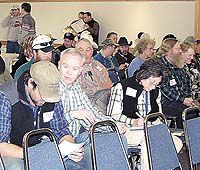| Participants in the range management seminar gather at the Museum of the San Rafael. There were more than 80 attendees. |
Utah State University Extension service hosted a range and pasture management seminar featuring eight specialists in the field at the Museum of the San Rafael recently. The seminar and lunch were free to local farmers and ranchers.
United States Department of Agriculture and the Agriculture Research Service scientists and personnel were the speakers and they presented all the latest research findings in the range and pasture management areas. Topics covered were animal nutrition, weed management and new plant developments for the improvement of pasture and rangeland.
Dr. Kevin Jensen, plant geneticist, was the first to present. He spoke about new developments in pasture grasses. He explained the top varieties of cool season grasses and their performance, along with the carbohydrate content and drought tolerance of each variety.
New development in legumes that enhance productivity of rangeland was the next topic and was presented by Dr. Michael Peel, plant geneticist. He explained studies that have been done comparing growth and production of alfalfa mixed with different types of grasses.
Dr. Blair Waldron, plant geneticist, was next with a topic of forage kochia; livestock, wildfire, reclamation and wildfire uses. Waldron was followed lowed by Dr. Joe Robins, also a plant geneticist who spoke about new developments in rangeland plants. He spoke about improved drought tolerance, persistence and seedling vigor.
Howard Horton, rangeland specialist was the first presenter following the lunch break. He spoke about rangeland and irrigated pasture. He gave the attendees information concerning early seedling establishment, seeding methods, and species compatibility.
Dr. Steve Dewey, weed specialist, presented concerning invasive weed problems and impacts on production. Dr. Randy Wiedmeier, animal scientist, presented on the topic of animal nutrition and performance on pastures and rangelands.
Dennis Worwood, Emery County agricultural extension educator was the final presenter of the workshop. He spoke about choosing the right species for your situation. Worwood is always available at the county building for answers and help to local farmers and ranchers with any problems that may arise in this area.
Worwood has materials available in his office concerning any of the topics covered in the seminar. He also has planting guides on CD available that specialize in the intermountain area and the species of plants and grasses that produce best and under which conditions. Contact Worwood at the extension office at 381-2381.Grow Crops for the New Energy Economy
A discussion was also held at the rangeland workshop on biodiesel. San Juan Biodiesel is planning a 5 million gallon per year oil extrusion and biodiesel production facility in Dove Creek, Colo. To operate the facility, SJB plans to contract for the production of sunflower and possibly canola crops within a 200 mile radius, including Emery and Carbon counties.
They did a presentation on oil seed crop production and the overall biodiesel process and also had a booth at the event all day, during which company representatives discussed crop rotations, production, contracting, logistics, and other factors in considering oil seed crop production. Sunflower is a good crop for highly alkaline soils: Sunflower is much more tolerant to salt than alfalfa hay, and should grow well on the highly alkaline soils of the region. Further, sunflower can be produced with low water demands.
Sunflower and canola make a good rotation crop for alfalfa hay and other grasses. When its time to tear out a stand of hay past its prime, sunflower is a viable option, such as in the sixth or seventh year after planting of the alfalfa stand. Crop budgeting analyses suggest that oil seed crop needs will be more profitable than growing oats and barley as the rotation crop for alfalfa.
At a $2.06 / bushel 10 year average and 90 bushel/acre yield, oats may gross approximately $185, with significant variable costs often greater than that. At 2200-3000 lbs/acre and a $12/100 cwt anticipated offer price, irrigated sunflower would bring a $312 gross, with generally low variable costs (often just three passes – plant, cultivate, and harvest). Meanwhile, sunflowers are generally drought tolerant, and can still give good yields with less irrigation as well.
Equipment used for grain crop production is easily adapted for sunflower planting and combining. San Juan Biodiesel is working with area farmers and the USU Extension office to assess the potential for several farmers to coop combine equipment. Given sunflowers large harvest window, co-oping equipment may be a viable option for several area farmers to coordinate larger acreages of production. San Juan Biodiesel also plans to lease or construct regional storage, and ship the oil seed from that storage to its facility over the course of the year. They plan to offer a premium for crops after harvest, likely beginning January of each year.

